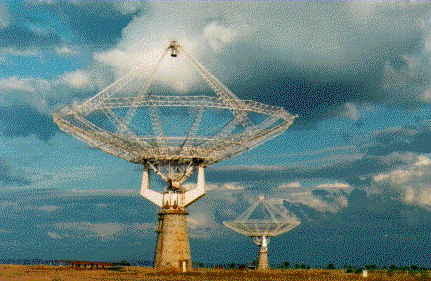Goals of GMRT

Although GMRT will be a very versatile instrument for investigating a variety of radio astrophysical problems ranging from our nearby Solar system to the edge of the observable Universe, two of its most important astrophysical objectives are:
- To detect the highly redshifted spectral line of neutral Hydrogen expected from protoclusters or protogalaxies before they condensed to form galaxies in the early phase of the Universe and
- To search for and study rapidly-rotating Pulsars in our galaxy.
Epoch of Galaxy Formation : Theories of the formation of structure in the Big-Bang Universe predict the presence of proto galaxies or proto clusters of galaxies made up of clouds of neutral Hydrogen gas before their gravitational condensation into galaxies. It should in principle be possible to detect these through the well known radio line emitted by neutral Hydrogen at a frequency of 1420 MHz. The line is however expected to be very weak and redshifted to metre wavelengths because of the expansion of the Universe between emission, billions of years ago, and detection at the present epoch. For clouds of Hydrogen between redshifts 3 and 10 (corresponding to epochs when the Universe had attained only a few percent of its present age), the line should be observable between frequencies of about 350 and 130 MHz. Detection of such neutral Hydrogen clouds is of fundamental astrophysical importance and can provide very important constraints to the theories of formation of galaxies and clusters.
Pulsars and Neutron Stars : GMRT should also be an ideal instrument for the study of Pulsars (rapidly rotating neutron stars with extremely high densities of about 200 million tons per cubic cm). Its large collecting area can lead to a 3 to 4-fold increase in the number of Pulsars known in our Galaxy. A particularly important programme in Pulsar research will be the search for extremely rapidly rotating pulsars with periods in the range of only milli-seconds and for pulsars in binary systems. Because of the strong gravitational fields associated with them, such systems form excellent laboratories for testing gravitational theories such as Einstein's General Theory of Relativity. Accurate timing measurements to detect extremely minute changes in the pulse arrival times from a group of pulsars could also lead to the detection of a weak background of gravitational radiation believed to have been generated by asymmetries in the very early Universe when it was less than a billionth of a billionth of a billionth of a second old!
Galactic and Extragalactic Radio Sources : Because of its large collecting area and wide frequency coverage, GMRT will be an invaluable and highly versatile instrument for studying many other problems at the frontiers of astrophysics. These include studies of Solar and planetary radio emissions; relationship between Solar activity and disturbances in the interplanetary medium; surveys of the Galactic plane to investigate the physics and evolution of clouds of ionized hydrogen associated with young stars as well as nonthermal emission from planetary nebulae and supernova remnants associated with late stages of stellar evolution; exotic types of stars and stellar systems whose radio emission could be hundreds of times more intense than that of the Sun; monitoring the variability of extragalactic radio sources, supernovae in external galaxies and transient sources in the Galactic plane; detection of the Deuterium line and Hydrogen recombination lines in the interstellar medium; halos and large-scale structure in spiral galaxies; structures and spectra of quasars and radio galaxies and their use in cosmological tests; studies of Hydrogen gas in external galaxies and streaming motions in the nearby Universe.
Document Actions
